Conflict and Negotiation: US-China Trade War and WTO Mediation Role
VerifiedAdded on 2022/08/25
|5
|1394
|15
Report
AI Summary
This report examines the international conflict arising from the 2018 US-China trade war, focusing on the imposition of tariffs and trade barriers by both nations. It analyzes the economic impacts, including trade deficits and technology transfer issues. The paper highlights the World Trade Organization (WTO) as the primary mediator, detailing its role in facilitating negotiations and establishing terms of trade. The report discusses the WTO's rulings, including the acknowledgment of unfair trade practices and the right to retaliate. It concludes that the WTO's facilitative mediation approach was effective in resuming trade relations and promoting long-term resolutions. The study also includes references to support the analysis and findings of the report.
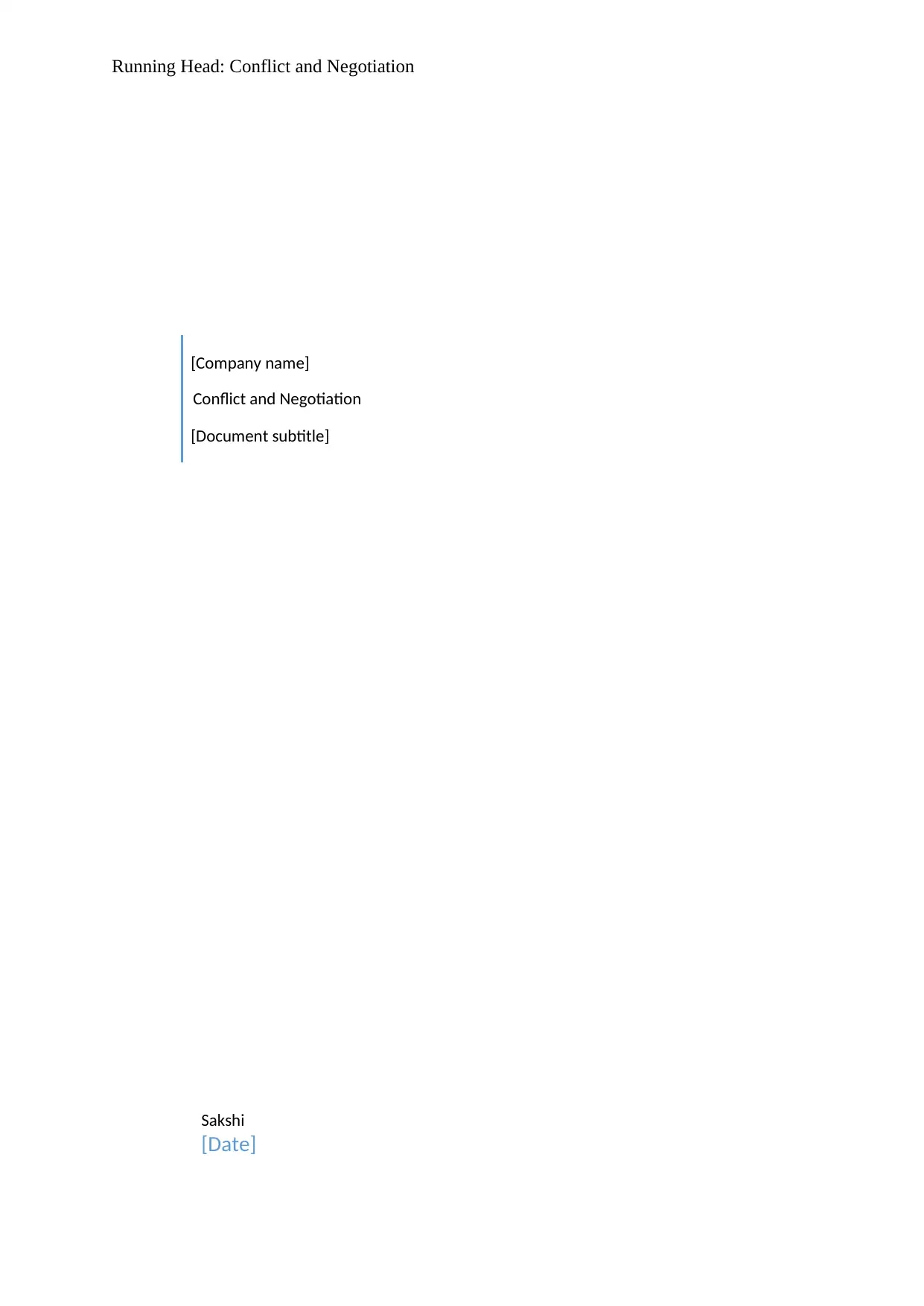
Running Head: Conflict and Negotiation
[Company name]
Conflict and Negotiation
[Document subtitle]
Sakshi
[Date]
[Company name]
Conflict and Negotiation
[Document subtitle]
Sakshi
[Date]
Paraphrase This Document
Need a fresh take? Get an instant paraphrase of this document with our AI Paraphraser
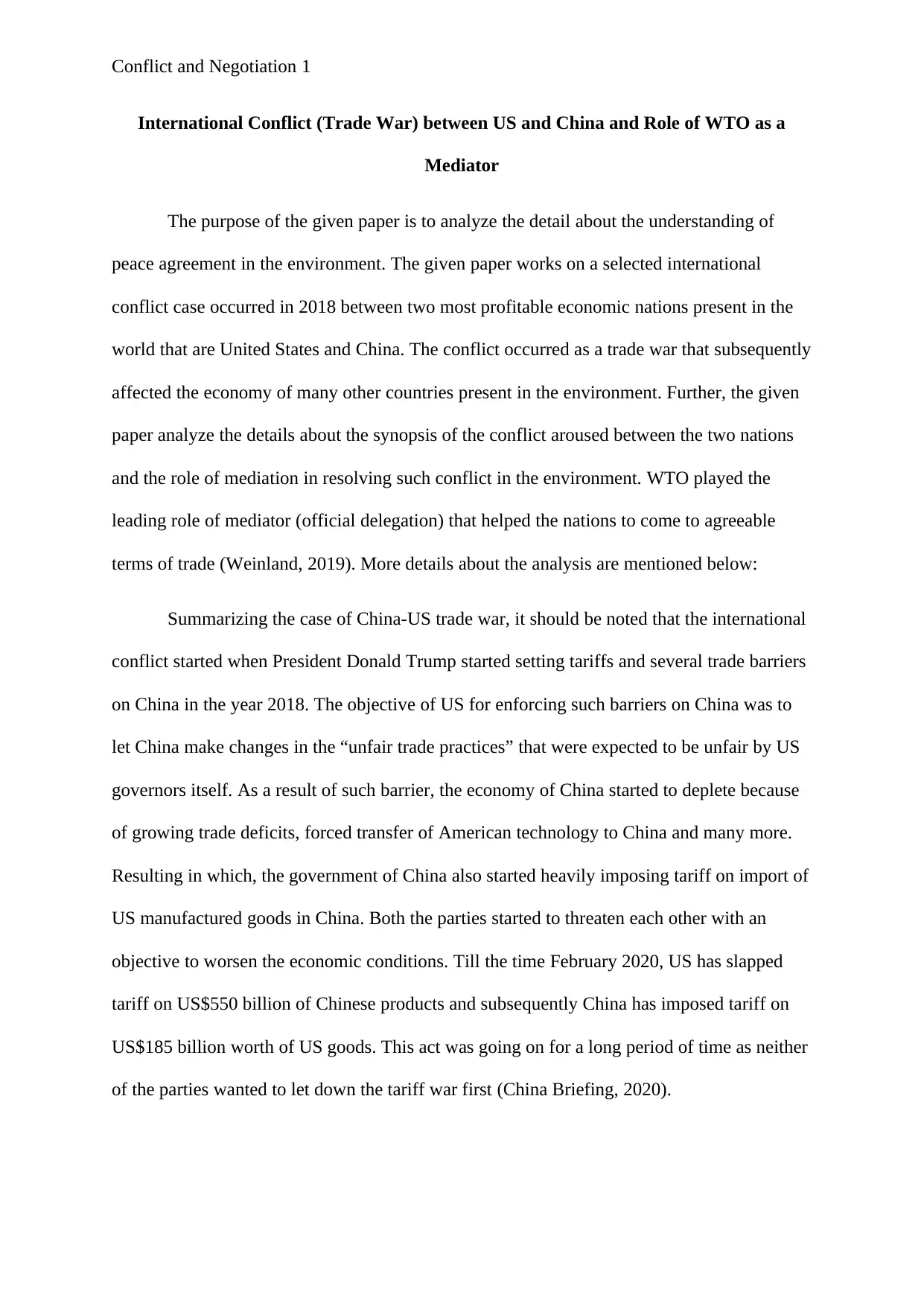
Conflict and Negotiation 1
International Conflict (Trade War) between US and China and Role of WTO as a
Mediator
The purpose of the given paper is to analyze the detail about the understanding of
peace agreement in the environment. The given paper works on a selected international
conflict case occurred in 2018 between two most profitable economic nations present in the
world that are United States and China. The conflict occurred as a trade war that subsequently
affected the economy of many other countries present in the environment. Further, the given
paper analyze the details about the synopsis of the conflict aroused between the two nations
and the role of mediation in resolving such conflict in the environment. WTO played the
leading role of mediator (official delegation) that helped the nations to come to agreeable
terms of trade (Weinland, 2019). More details about the analysis are mentioned below:
Summarizing the case of China-US trade war, it should be noted that the international
conflict started when President Donald Trump started setting tariffs and several trade barriers
on China in the year 2018. The objective of US for enforcing such barriers on China was to
let China make changes in the “unfair trade practices” that were expected to be unfair by US
governors itself. As a result of such barrier, the economy of China started to deplete because
of growing trade deficits, forced transfer of American technology to China and many more.
Resulting in which, the government of China also started heavily imposing tariff on import of
US manufactured goods in China. Both the parties started to threaten each other with an
objective to worsen the economic conditions. Till the time February 2020, US has slapped
tariff on US$550 billion of Chinese products and subsequently China has imposed tariff on
US$185 billion worth of US goods. This act was going on for a long period of time as neither
of the parties wanted to let down the tariff war first (China Briefing, 2020).
International Conflict (Trade War) between US and China and Role of WTO as a
Mediator
The purpose of the given paper is to analyze the detail about the understanding of
peace agreement in the environment. The given paper works on a selected international
conflict case occurred in 2018 between two most profitable economic nations present in the
world that are United States and China. The conflict occurred as a trade war that subsequently
affected the economy of many other countries present in the environment. Further, the given
paper analyze the details about the synopsis of the conflict aroused between the two nations
and the role of mediation in resolving such conflict in the environment. WTO played the
leading role of mediator (official delegation) that helped the nations to come to agreeable
terms of trade (Weinland, 2019). More details about the analysis are mentioned below:
Summarizing the case of China-US trade war, it should be noted that the international
conflict started when President Donald Trump started setting tariffs and several trade barriers
on China in the year 2018. The objective of US for enforcing such barriers on China was to
let China make changes in the “unfair trade practices” that were expected to be unfair by US
governors itself. As a result of such barrier, the economy of China started to deplete because
of growing trade deficits, forced transfer of American technology to China and many more.
Resulting in which, the government of China also started heavily imposing tariff on import of
US manufactured goods in China. Both the parties started to threaten each other with an
objective to worsen the economic conditions. Till the time February 2020, US has slapped
tariff on US$550 billion of Chinese products and subsequently China has imposed tariff on
US$185 billion worth of US goods. This act was going on for a long period of time as neither
of the parties wanted to let down the tariff war first (China Briefing, 2020).
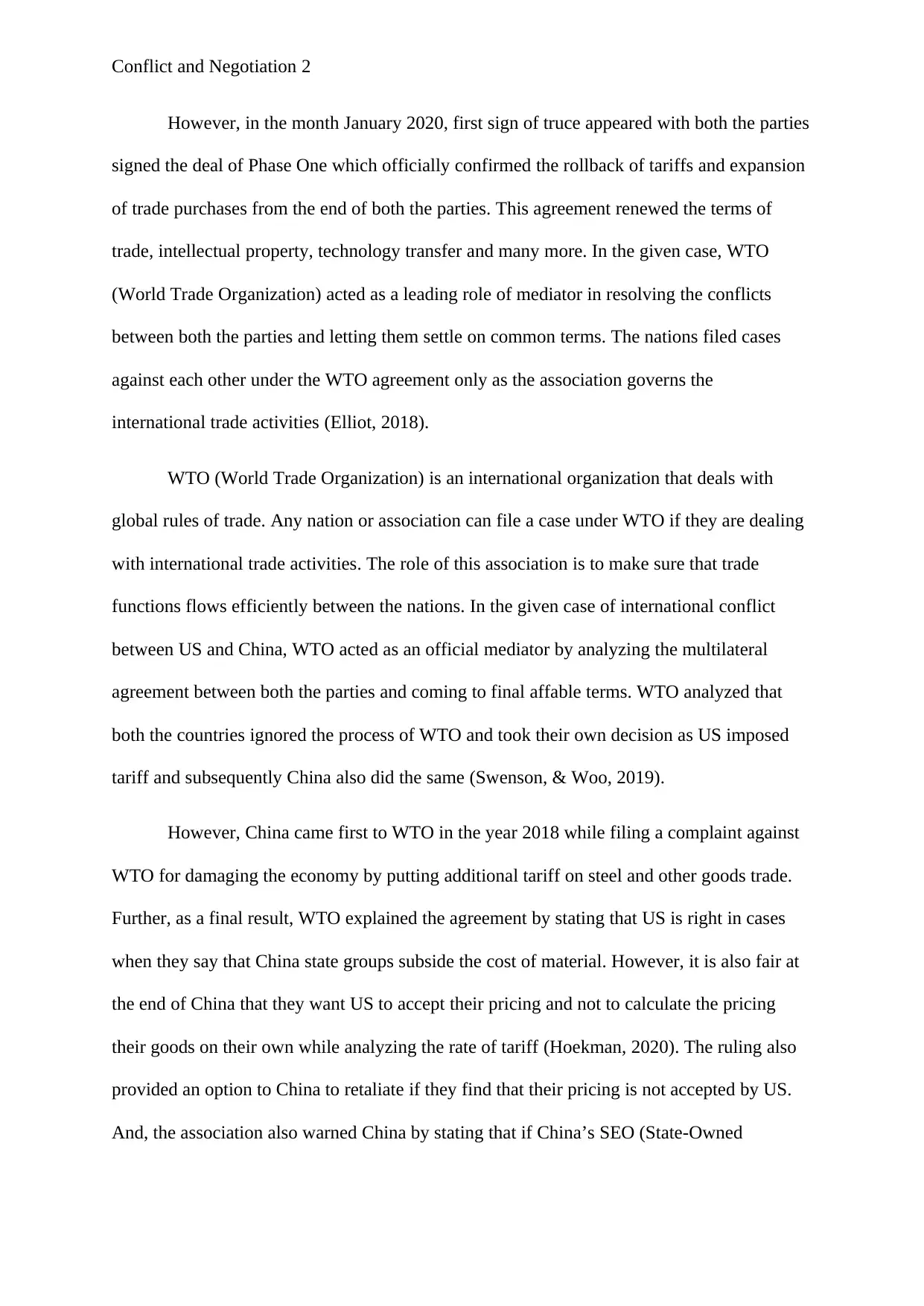
Conflict and Negotiation 2
However, in the month January 2020, first sign of truce appeared with both the parties
signed the deal of Phase One which officially confirmed the rollback of tariffs and expansion
of trade purchases from the end of both the parties. This agreement renewed the terms of
trade, intellectual property, technology transfer and many more. In the given case, WTO
(World Trade Organization) acted as a leading role of mediator in resolving the conflicts
between both the parties and letting them settle on common terms. The nations filed cases
against each other under the WTO agreement only as the association governs the
international trade activities (Elliot, 2018).
WTO (World Trade Organization) is an international organization that deals with
global rules of trade. Any nation or association can file a case under WTO if they are dealing
with international trade activities. The role of this association is to make sure that trade
functions flows efficiently between the nations. In the given case of international conflict
between US and China, WTO acted as an official mediator by analyzing the multilateral
agreement between both the parties and coming to final affable terms. WTO analyzed that
both the countries ignored the process of WTO and took their own decision as US imposed
tariff and subsequently China also did the same (Swenson, & Woo, 2019).
However, China came first to WTO in the year 2018 while filing a complaint against
WTO for damaging the economy by putting additional tariff on steel and other goods trade.
Further, as a final result, WTO explained the agreement by stating that US is right in cases
when they say that China state groups subside the cost of material. However, it is also fair at
the end of China that they want US to accept their pricing and not to calculate the pricing
their goods on their own while analyzing the rate of tariff (Hoekman, 2020). The ruling also
provided an option to China to retaliate if they find that their pricing is not accepted by US.
And, the association also warned China by stating that if China’s SEO (State-Owned
However, in the month January 2020, first sign of truce appeared with both the parties
signed the deal of Phase One which officially confirmed the rollback of tariffs and expansion
of trade purchases from the end of both the parties. This agreement renewed the terms of
trade, intellectual property, technology transfer and many more. In the given case, WTO
(World Trade Organization) acted as a leading role of mediator in resolving the conflicts
between both the parties and letting them settle on common terms. The nations filed cases
against each other under the WTO agreement only as the association governs the
international trade activities (Elliot, 2018).
WTO (World Trade Organization) is an international organization that deals with
global rules of trade. Any nation or association can file a case under WTO if they are dealing
with international trade activities. The role of this association is to make sure that trade
functions flows efficiently between the nations. In the given case of international conflict
between US and China, WTO acted as an official mediator by analyzing the multilateral
agreement between both the parties and coming to final affable terms. WTO analyzed that
both the countries ignored the process of WTO and took their own decision as US imposed
tariff and subsequently China also did the same (Swenson, & Woo, 2019).
However, China came first to WTO in the year 2018 while filing a complaint against
WTO for damaging the economy by putting additional tariff on steel and other goods trade.
Further, as a final result, WTO explained the agreement by stating that US is right in cases
when they say that China state groups subside the cost of material. However, it is also fair at
the end of China that they want US to accept their pricing and not to calculate the pricing
their goods on their own while analyzing the rate of tariff (Hoekman, 2020). The ruling also
provided an option to China to retaliate if they find that their pricing is not accepted by US.
And, the association also warned China by stating that if China’s SEO (State-Owned
⊘ This is a preview!⊘
Do you want full access?
Subscribe today to unlock all pages.

Trusted by 1+ million students worldwide
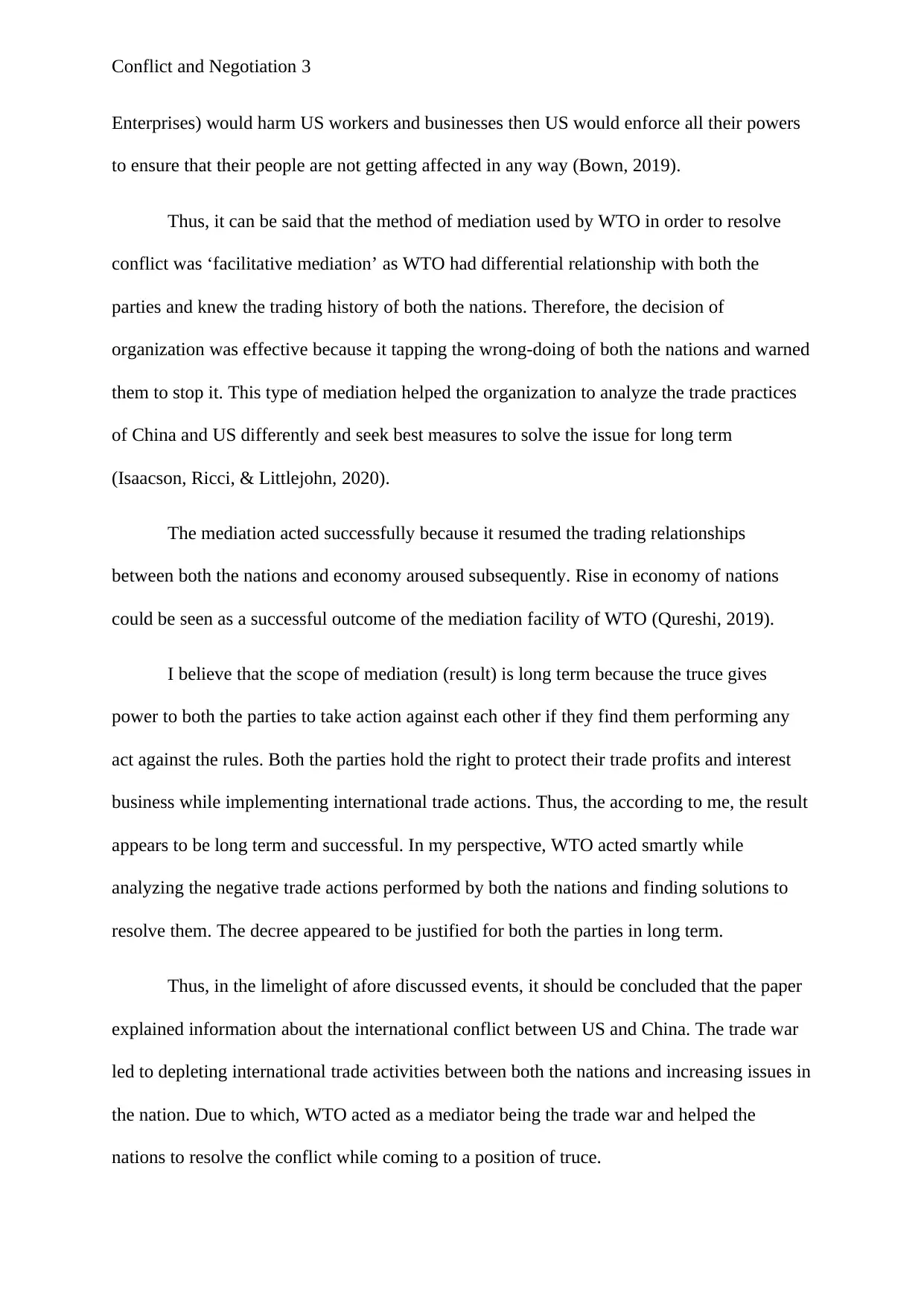
Conflict and Negotiation 3
Enterprises) would harm US workers and businesses then US would enforce all their powers
to ensure that their people are not getting affected in any way (Bown, 2019).
Thus, it can be said that the method of mediation used by WTO in order to resolve
conflict was ‘facilitative mediation’ as WTO had differential relationship with both the
parties and knew the trading history of both the nations. Therefore, the decision of
organization was effective because it tapping the wrong-doing of both the nations and warned
them to stop it. This type of mediation helped the organization to analyze the trade practices
of China and US differently and seek best measures to solve the issue for long term
(Isaacson, Ricci, & Littlejohn, 2020).
The mediation acted successfully because it resumed the trading relationships
between both the nations and economy aroused subsequently. Rise in economy of nations
could be seen as a successful outcome of the mediation facility of WTO (Qureshi, 2019).
I believe that the scope of mediation (result) is long term because the truce gives
power to both the parties to take action against each other if they find them performing any
act against the rules. Both the parties hold the right to protect their trade profits and interest
business while implementing international trade actions. Thus, the according to me, the result
appears to be long term and successful. In my perspective, WTO acted smartly while
analyzing the negative trade actions performed by both the nations and finding solutions to
resolve them. The decree appeared to be justified for both the parties in long term.
Thus, in the limelight of afore discussed events, it should be concluded that the paper
explained information about the international conflict between US and China. The trade war
led to depleting international trade activities between both the nations and increasing issues in
the nation. Due to which, WTO acted as a mediator being the trade war and helped the
nations to resolve the conflict while coming to a position of truce.
Enterprises) would harm US workers and businesses then US would enforce all their powers
to ensure that their people are not getting affected in any way (Bown, 2019).
Thus, it can be said that the method of mediation used by WTO in order to resolve
conflict was ‘facilitative mediation’ as WTO had differential relationship with both the
parties and knew the trading history of both the nations. Therefore, the decision of
organization was effective because it tapping the wrong-doing of both the nations and warned
them to stop it. This type of mediation helped the organization to analyze the trade practices
of China and US differently and seek best measures to solve the issue for long term
(Isaacson, Ricci, & Littlejohn, 2020).
The mediation acted successfully because it resumed the trading relationships
between both the nations and economy aroused subsequently. Rise in economy of nations
could be seen as a successful outcome of the mediation facility of WTO (Qureshi, 2019).
I believe that the scope of mediation (result) is long term because the truce gives
power to both the parties to take action against each other if they find them performing any
act against the rules. Both the parties hold the right to protect their trade profits and interest
business while implementing international trade actions. Thus, the according to me, the result
appears to be long term and successful. In my perspective, WTO acted smartly while
analyzing the negative trade actions performed by both the nations and finding solutions to
resolve them. The decree appeared to be justified for both the parties in long term.
Thus, in the limelight of afore discussed events, it should be concluded that the paper
explained information about the international conflict between US and China. The trade war
led to depleting international trade activities between both the nations and increasing issues in
the nation. Due to which, WTO acted as a mediator being the trade war and helped the
nations to resolve the conflict while coming to a position of truce.
Paraphrase This Document
Need a fresh take? Get an instant paraphrase of this document with our AI Paraphraser
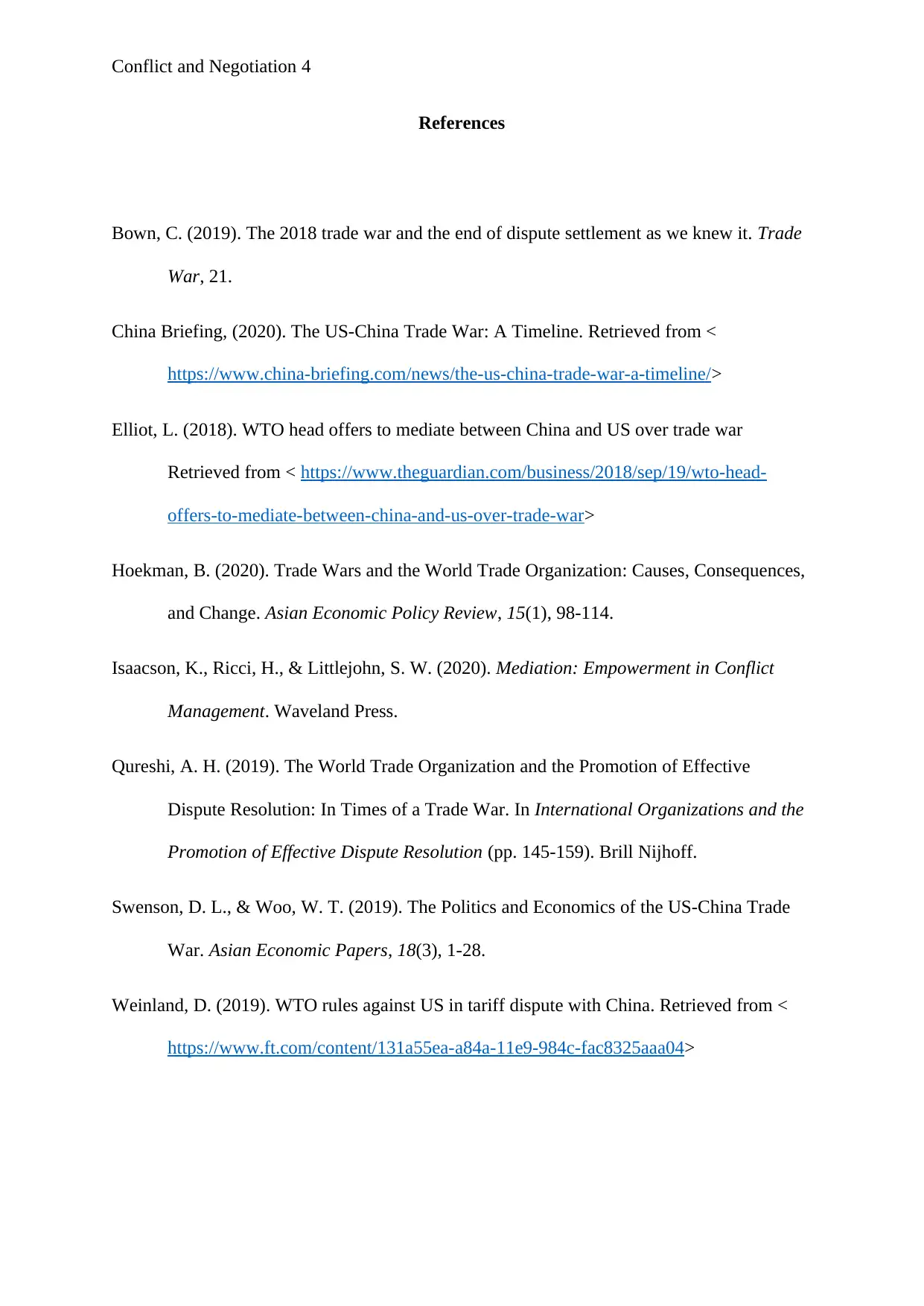
Conflict and Negotiation 4
References
Bown, C. (2019). The 2018 trade war and the end of dispute settlement as we knew it. Trade
War, 21.
China Briefing, (2020). The US-China Trade War: A Timeline. Retrieved from <
https://www.china-briefing.com/news/the-us-china-trade-war-a-timeline/>
Elliot, L. (2018). WTO head offers to mediate between China and US over trade war
Retrieved from < https://www.theguardian.com/business/2018/sep/19/wto-head-
offers-to-mediate-between-china-and-us-over-trade-war>
Hoekman, B. (2020). Trade Wars and the World Trade Organization: Causes, Consequences,
and Change. Asian Economic Policy Review, 15(1), 98-114.
Isaacson, K., Ricci, H., & Littlejohn, S. W. (2020). Mediation: Empowerment in Conflict
Management. Waveland Press.
Qureshi, A. H. (2019). The World Trade Organization and the Promotion of Effective
Dispute Resolution: In Times of a Trade War. In International Organizations and the
Promotion of Effective Dispute Resolution (pp. 145-159). Brill Nijhoff.
Swenson, D. L., & Woo, W. T. (2019). The Politics and Economics of the US-China Trade
War. Asian Economic Papers, 18(3), 1-28.
Weinland, D. (2019). WTO rules against US in tariff dispute with China. Retrieved from <
https://www.ft.com/content/131a55ea-a84a-11e9-984c-fac8325aaa04>
References
Bown, C. (2019). The 2018 trade war and the end of dispute settlement as we knew it. Trade
War, 21.
China Briefing, (2020). The US-China Trade War: A Timeline. Retrieved from <
https://www.china-briefing.com/news/the-us-china-trade-war-a-timeline/>
Elliot, L. (2018). WTO head offers to mediate between China and US over trade war
Retrieved from < https://www.theguardian.com/business/2018/sep/19/wto-head-
offers-to-mediate-between-china-and-us-over-trade-war>
Hoekman, B. (2020). Trade Wars and the World Trade Organization: Causes, Consequences,
and Change. Asian Economic Policy Review, 15(1), 98-114.
Isaacson, K., Ricci, H., & Littlejohn, S. W. (2020). Mediation: Empowerment in Conflict
Management. Waveland Press.
Qureshi, A. H. (2019). The World Trade Organization and the Promotion of Effective
Dispute Resolution: In Times of a Trade War. In International Organizations and the
Promotion of Effective Dispute Resolution (pp. 145-159). Brill Nijhoff.
Swenson, D. L., & Woo, W. T. (2019). The Politics and Economics of the US-China Trade
War. Asian Economic Papers, 18(3), 1-28.
Weinland, D. (2019). WTO rules against US in tariff dispute with China. Retrieved from <
https://www.ft.com/content/131a55ea-a84a-11e9-984c-fac8325aaa04>
1 out of 5
Related Documents
Your All-in-One AI-Powered Toolkit for Academic Success.
+13062052269
info@desklib.com
Available 24*7 on WhatsApp / Email
![[object Object]](/_next/static/media/star-bottom.7253800d.svg)
Unlock your academic potential
Copyright © 2020–2025 A2Z Services. All Rights Reserved. Developed and managed by ZUCOL.





